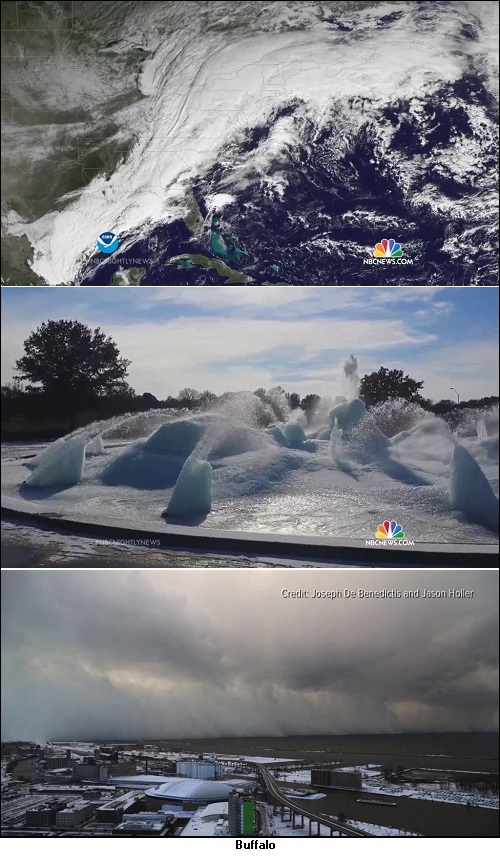
|
|

|
|
| April 19, 2024 |
|
More than half the continental U.S covered in snow 
There was already 4 feet of snow on the ground at noon Tuesday in Elma, N.Y., and it was snowing so hard Dennis Powers couldn't see out his window. "We're getting hammered," said Powers, supervisor for the town of 11,300 people less than 20 miles from Lake Erie. "We could get 2-3 more feet of snow. And the wind chill is 2 degrees. So it's cold."
Plummeting temperatures and lake-effect snow brought weather havoc to much of the North and East, with some areas battling snow measured in feet and white-out highway conditions. The U.S. awoke Tuesday to its coldest November morning since 1976, WeatherBell meteorologist Ryan Maue said. More than 85% of the 48 contiguous states, and 226 million Americans, reached or fell below freezing, he said. The National Weather Service reported that every state saw freezing temperatures. The blast of Arctic air set off a lake-effect snowstorm across parts of the New York, Pennsylvania, Ohio, Michigan and Wisconsin. Some areas could see 6 feet of snow before the storm is over, the National Weather Service said. More bad news: The snow will hang around in some areas through Friday, AccuWeather senior meteorologist Tim Kines warned. Actually, more than half the continental U.S. is covered in snow, a phenomenon more common in January and February, Kines said. He added that the snow bands are moving and that no place is likely to see blinding snow all week long. The bands in some places are only 5 miles wide, he added. "There are places that are getting 40 inches of snow, and 5 miles away they have a couple inches," Kines said. Travel bans and states of emergency dotted the nation's northern tier. In the Buffalo area, I-90 was closed in both directions as up to 3 feet of snow had fallen in parts of the city early Tuesday. Schools were closed across much of the region. State troopers were using all-terrain vehicles to deliver blankets and other emergency supplies to motorists stranded on the Thruway overnight, said state police Capt. Ed Kennedy. It wasn't known yet how many people were stuck in their vehicles Tuesday, he said. "Other than wishing they weren't stuck in traffic, they're warm and safe in their vehicles," he said. Erie County, N.Y., Executive Mark Poloncarz said local officials learned a lot from a crippling blizzard that hit the region last year. "What I think came out of that was the understanding that if we want to handle these storms appropriately, we need to have communication even before the snow happens," he said. " And that's what has happened." Communication can go only so far. Powers said cleanup was slowed in Elma when two plows became stuck in the snow. Vehicles abandoned on roads aren't helping. Local travel bans have been mostly successful, but Powers says some residents have called with complaints. "People are complaining about missing work, but I'm saying, 'Guys, this is a major storm, even for us," he said. As crazy as this snowfall is, it's not likely to be a record: Montague, N.Y., once picked up 77 inches of snow in 24 hours, on Jan. 11-12, 1987, reports Weather Underground weather historian Chris Burt. The cold temperatures extended far beyond the snowfall. Temperatures 20 degrees below average were common from Gulf Coast and northward into the Northeast, the weather service reported. Record-low temperatures are likely Tuesday and Wednesday from Idaho to Nebraska and Iowa south to Texas and east through the Great Lakes, Maue reported. Overall, the eastern two-thirds of the U.S. will shatter decades-long, and in some cases century-long, records. Temperatures east of the Rockies will be 20-40 degrees below average. Amazingly, it's forecast to be warmer in Anchorage (34 degrees) on Wednesday morning than in Tallahassee, Fla. (22 degrees), the Weather Channel predicts. Indeed, the eastern half of North America is an outlier: It's the one part of the entire Northern Hemisphere that's having such dramatically below-average, frigid temperatures, according to the University of Maine. Overall, the hemisphere is about 1.35 degrees warmer than average for Nov. 18. The weather service warned that similar conditions should continue Wednesday before the cold snap slowly eases Thursday. (Source: USA Today) Story Date: November 19, 2014
|